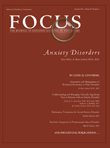I have a patient who has a debilitating fear of flying and who heard about virtual reality exposure therapy. Can you tell me more about this type of therapy and what I can advise her to expect?
Virtual reality (VR) is a multimedia computer interaction in which users are active participants within a computer-generated three-dimensional virtual world. Virtual environments differ from traditional computer displays in that the user experiences a sense of presence or immersion in the virtual environment. We consider this presence important for exposure therapy. VR exposure (VRE) is intended to be a component of a comprehensive treatment package and is recommended at the point in therapy when exposure therapy would be introduced.
The most common approach is for the user to wear a head-mounted display. Head-mounted displays are like helmets with separate mini-TV screens for each eye, earphones, and a head-tracking device. This technology integrates real-time computer graphics, body tracking devices, visual displays, and other sensory input devices to immerse a participant in a computer-generated virtual environment that changes in a natural way with head and body motion. For some environments, users may also hold a second position sensor or joystick in their hands that allows them to manipulate or move around the virtual environment, for example, to use a virtual hand to push an elevator button and ascend or to move a Humvee down a desert highway.
Exposure therapy is the treatment of choice for many of the anxiety disorders, especially when avoidance is a prominent symptom. Approximately one-half of patients with a fear of flying (FOF) meet the criteria for panic disorder and about one-half meet criteria for specific phobia, all of whom have been shown to respond to VRE therapy (
1,
2). Two randomized clinical trials have been published comparing VR to in vivo exposure for the FOF (
1,
2) and indicated that VRE was as effective as standard in vivo exposure. Follow-up data indicate that treatment gains were maintained at 6 and 12 months posttreatment. VRE has the advantages of conducting time-consuming exposure therapy without leaving the therapist's office and offering more control over exposure stimuli and less exposure of the patient to possible harm or embarrassment. For the FOF, for example, airplane “trips” can be conducted by VRE without leaving the therapist's office, and the appropriate stimuli presented. If the patient is not ready for turbulence, we can guarantee no turbulence but can introduce it at the appropriate point in therapy. The therapist can see on the computer monitor what the patient views in the head-mounted display and therefore can comment appropriately and encourage continued exposure until anxiety decreases. For virtual environments such as the Virtual Iraq with loud audio stimuli (e.g., explosions and gunfire), the therapist communicates with the patient with a microphone heard over the earphones. Some environments also include vibrations and odors delivered at the appropriate points in the scenes. For the FOF, the patient can feel the vibrations of the airplane engine and turbulence from a speaker mounted in the raised platform underneath the chair.
In the first published controlled study applying VR to the treatment of a psychiatric disorder, VRE was incorporated in the treatment of acrophobia (fear of heights) (
3). Participants were repeatedly exposed to virtual foot bridges of varying heights and stability, outdoor balconies of varying heights, and a glass elevator that ascended 50 floors. VRE was effective in significantly reducing fear of and improving attitudes toward heights, whereas no change was noted in the control group. More importantly, 7 of the 10 VRE treatment completers exposed themselves to real-life height situations by the end of treatment although they were not instructed to do so.
VRE has been applied to several anxiety disorders, substance use disorders, and speech fluency disorders. A growing body of literature supports the use of VRE as a tool for exposure therapy within a comprehensive treatment program (
4), with two meta-analyses indicating large effect sizes (
5,
6). Several case studies or open clinical trials support the use of VR in the treatment of anxiety disorders, including posttraumatic stress disorder, FOF, fear of public speaking, specific phobia of spiders, and claustrophobia.

